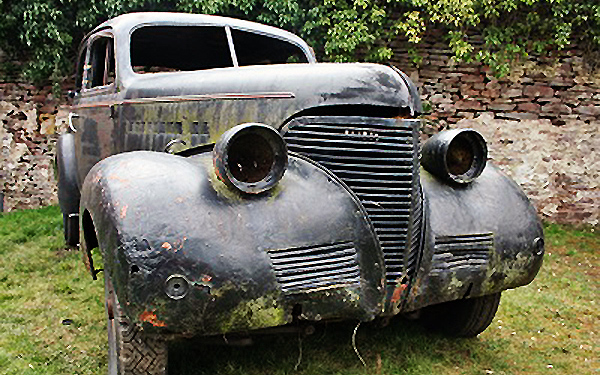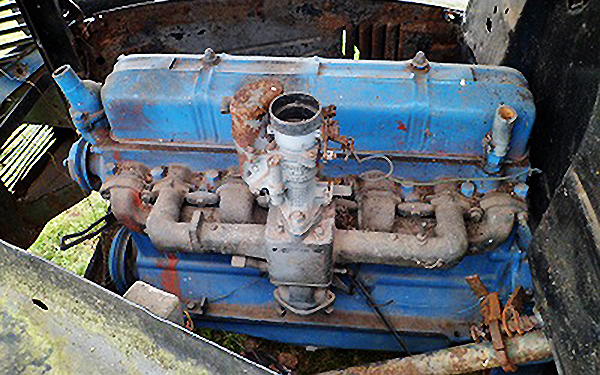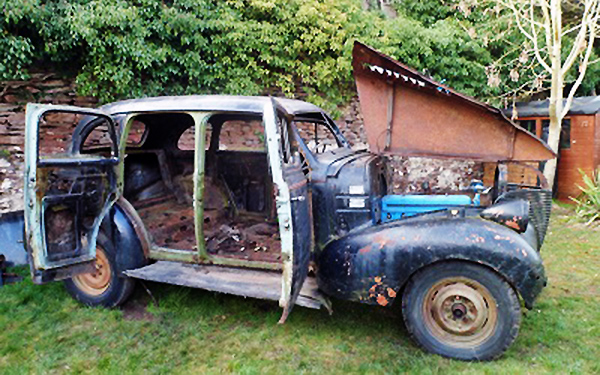Reader Liam W has found a number of interesting finds over in the UK and it seems he has come across another one. This time he came across this 1939 Chevrolet Master Deluxe and while he thinks it would make a great hot rod, we think its possible history as a US Army staff car during WWII makes it a better candidate for a restoration. While the market for hot rods might be bigger than the Army staff car market, cars like this are an important part of our history and should be preserved for generations to come. The real challenge though, is proving it was a staff car and whether it was involved in any important missions. Liam hopes to find a good home for this Chevy regardless of its history, so if you’re interested in it, click here to send him an email.
The Master Deluxe series was introduced in 1934 and even with the rough economic times, did very well. Styling was elegant, but not over the top and looked similar enough to a Cadillac to grab the attention of both price conscious and well to do buyers. By the time this one was built, the Master series had also established itself as durable and dependable, making it a very appealing option for the US Army as a staff car. For the most part, Chevy didn’t have to do much to make these ready for military duty. The most noticeable difference was the flat green paint and the large white Army Star on each side.
Chevy installed their Stovebolt straight six in the Master series, which gave the car decent power for the day, about 80 horsepower. It also proved to be highly dependable and required minimal service, making it a great option for the Army. Staff cars need to be able to transport officers and other high level officials in and out of the battle field as quickly and safely as possible, making the Stovebolt powered Master a great choice. Liam claims the engine was rebuilt prior to being stored a number of years ago, but is missing some pieces. If it turns freely, it shouldn’t be too difficult to get it running again and parts should be easy to come by. Finding mechanical parts will be the least of the next owner’s concerns though, as the interior is completely missing. Finding the interior pieces shouldn’t be impossible, but could get expensive and time consuming.
This Chevy is going to need a lot of work, which could explain why Liam feels it would be better suited as a hot rod. If it turns out to have seen action during the war, we feel it should be restored to original, as this is just too important of history to be lost. There have been many cars from this era turned into staff car replicas, so be sure to inspect it closely and check for any data plates indicating military ownership. Getting it over to the States could be a challenge, but Liam says he is willing to help ship it internationally. So would you restore this back to military spec, hot rod it, or put it back in the barn?






USA all the way. Prove its provenience and bring it back to military spec.
Wouldnt it simply be worth more in England.also considering the $3000 to send it back home?
Less yank tanks in Europe obviously and If like here in Aussie yankee cars are worth more money than in its homeland. in fact there is a big industry importing USA cars here, surely Europe loves em’ too?
And the military collector thing is just as big in Europe as US and even if it wasnt a staff car its gotta be worth more in europe, yet its probably got more chance of having been a staff car over there than one still in USA as thats more likely the reason it was there in the first place.
I myself have a Skoda roadster I was going to turn into a Axis staff car and A Morris 8 series 2 that I was going to turn into a WW2 Morris radio car..The military thing is big in Europe…bet it stays there as I am sure they are fairly obtainable in US and cheaper than the transport costs in this condition compared to the scarcity in Europe.
My vote would be to restore it to its Military Heritage!!
Look for evidence of any olive drab paint. But, even WW2 restored Jeeps don’t bring a fortune. Just rust repair and paint make this a no no.
No to being converted to a hot rod, just to gangly in design. Here in the Southwest U.S (Arizona, Utah,Texas etc) you can still see these in bone yards, there is no money in them……….
Armed forces cars for WWII were USUALLY 1941 models with blacked out chrome. The 1939 year makes me skeptical unless there is more documentation showing it was an older car from an embassy, air base or something…
Wow mark great point.. didnt even look at the date of it.
Might pass this by you..What’s your thoughts on ..that the US army may have sent older models [which may have been still left on unsold on lots or in factory? for staff cars too…
or through the lend lease program or perhaps as US political/military officers working in england during the lend lease period /pre US actual military involvement..the lend lease program was huge and I am sure there would be many US military people stationed or visiting England….[I am a military modellor with much reading.]
I know in Australia we repatriated all sorts of cars and ages for military service and I’ll bet US had staff cars here before they became involved due to our proximity to the pacific though we had always had Australian bodied US cars here for private use.. My dad remembers many US military personal vehicles here when he was about to be posted overseas. So I am sure England would have quite a few US vehicles around too before US involvement.
The Lend Lease program was the Allies saving grace. cheers to the US.
a 1939 may still have been unused and appropriate for shipping over.??
Hi Mark, thank you for the information. The only confirmation I have of the year of the car being 1939, is from information the previous owner told me. It could well be a different year? I have no paperwork for the car, which is not helping things, as the car has never been registered here in the UK, and I have no paperwork from when it was brought to the UK, which is believed to be about 10 years ago. Until such time as I can decipher the vin plates, in the hope it will shed some more light on the cars actual date, I wont know for sure. Would you know if all of these cars have 6 stud wheel hubs?? A few people have told me they are surprised it has 6 studs instead of 5, and that 6 studs might show it was intended for Military use, hence having heavier duty hubs fitted?? I must stress here, that I know nothing about this car, only what I have been told by others and previous owner! I wont really know anything for sure until the vin tags are decoded, or someone can tell me more about it. Also, 2 of the tyres (tires) are vintage heavy duty types, ‘similar’ to the type of tyre used on old Jeeps, and the other 2 tyres, although also of vintage origin, are more suitable for road use only. I do not know if the tyre information can tell you anything about it or not, but it is worth mentioning, as sometimes a clue to a cars past can be in the smallest of details.
There were no five lug Chevrolets in 1939, so this isn’t heavy duty, or special. All Chevys of the era, up to 1954 in fact, had 6 lug wheels. The same lug pattern is still used on some Chevy and GMC trucks. Most six lug American and Japanese vehicles use the same lug pattern to this day. The tires are not a clue, as a staff car of this sort would never have been fitted with anything other than street tires, and certainly never with non-directional tread tires like a Jeep.
@ Mark E: Agreed. I would imagine a military staff car would have been a 1941 or 1942 model as the US entered the war early during the 1942 model year (December 7, 1941) and all new car production stopped for the shift to war production shortly after that. I can also see evidence of three paint jobs (original black, metallic pea soup green and black again), but nothing in olive drab. Without provenance it is simply impossible to prove anything about this car except for the model year (cars at this time had enough styling changes from year to year to be unique), which appears to me to be a 1939. As to why the car has no chrome, it is missing a lot of trim and the whole car appears to have been painted with some sort of black paint at one point while it may have been yard art. After all, the wheels don’t match and seem to have much more modern (but still old) tires on them. Also, a tall ride height would have been common when this car was new since nice, smooth roads were not as common as they are today. Many cars of this time would have been expected to drive down rutted dirt roads on a regular basis and were designed accordingly.
Restoration would be an expensive affair. Fischer Bodies of the era usually were a wooden skeleton with steel used to skin it, unlike Fords which were all steel. I am not 100% certain that they used this method this late, but if they did it would make restoration much harder. You would also need to source all of the trim, glass and interior, which would likewise run up costs-and I haven’t even gotten to the body and mechanical parts yet. No, even in the UK restoring this car back to stock is not a great idea. It would be cheaper to buy a good one in the US and export it as they aren’t exactly the most beloved of cars here. The best someone may end up doing with this car is building a rat rod out of it as that option only requires that it moves and stops and not that it looks good. Even there, the formal body style would make it far from a favorite among that crowd.
Thanks for the comments guys. The car is much more solid than it looks. The photos dont really make it look its best. The floor pan for example, is totally solid and has never been welded. There are several evidential areas of Olive Drab paint, underside of doors, trunk floor, glove box lid etc. It came in to the UK about 10 years ago, but has never been registered in the UK, so finding its history will be time consuming. I have got the VIn plates still on the car though, so I will be making some enquiries where I can. I do not have the time to devote to the car like I would to. For those of you that recognise my name and finds on here, you will know that I am always finding old cars, and quite often it seems, not long before they are due to be crushed. So it has become quiet a busy hobby for me. I have photos of far more barn finds, field and bush finds etc etc, than barnfinds.com could ever possibly show on here, which I am still trying to save from inevitable ends in places we would rather they did not go. So I try to get as many of them as I can, and find new homes for them as quickly as I can, so I can then move on and bring other barn finds home and do it all again. My point being, I do not have the time to fully research all the details of any one car, because all that time doing that, is time I could spend dragging more cars out of barns etc It is also space at home for them. I currently have 5 cars in my drive I have pulled form various places, and looking for homes for, and finding homes for them in itself is time consuming. I also have of my own classics at home, so I need space asap, as I have other finds I have secured, and waiting to bring home. It is a shame in a way, as I really do find some very interesting cars at times, and as much as I would just love to be able to find out everything about all of them, I just cant possibly do it. So I hope exposure on barnfinds.com and word of mouth etc, will find some interested people looking to save an old car…..
Thank you for the comments guys. I have no intentions of restoring this car as per my previous comments. It is because of the cars condition and the amount of missing parts, that my suggestion is that this car would be best suited as a Hot Rod, as it does matter on a Rod if you have after market interior or bumpers etc etc, as Rodders will usually change a lot of that anyway. When I got the car last week, I checked them out on line in the US and could see they do not fetch much money there, and are quite common still. Over here, they are not a common sight at all, and for anyone into Rods, be it Rad or show Rod, it would be an unusual car compared to many other cars more commonly used as Rods. Either way, whatever anyone wants to do with it, is up to the whoever may buy it, I simply want to find a home for it and give it a chance of returning to the road somehow, and I hope that happens. Otherwise it will go back in a barn somewhere again which would be a shame. As it was, I got hold of it because it was going to be smashed up in a stock car/banger cartype race as they call them here, which I could not let happen to this old car. Whatever condition it may be in,and whatever people may feel about it, once these old cars are gone, they are gone forever, and should be saved somehow where possible, and not smashed up for ‘fun’ by some neanderthal on his first lap around a track.
Hi really surprised to see this as we owned this car for a short time. When we bought it the owner told us that it had never been registered in the UK but in fact had been imported from Czechoslovacia. We bought the car to Banger race so hopefully it’s going to be around for plenty more years to come.